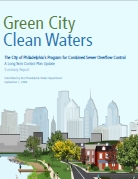FLASHBACK TO 2011: Watch Philadelphia's "Green City, Clean Waters" Video – "Changing the world, or even one small piece of, requires a lot of trial and error," stated Howard Neukrug, the visionary behind Philadelphia's bold plan to peel back the concrete and asphalt and replace it with green infrastructure
Note to Reader:
The GreenTreks Network produced a video to show how the City of Philadelphia is reducing rainwater runoff and stormwater infrastructure costs using “green infrastructure”.
GreenTreks Network is an award-winning non-profit whose mission is moving people to take action towards a more sustainable lifestyle. GreenTreks mobilize all modes of communication to share the personal stories of ordinary individuals doing extraordinary things for a healthier, more prosperous future—and inspire others to become involved. Telling Stories that Change the World.
Green City, Clean Waters
When it rains in the City of Brotherly Love, problems soon follow because more than half the city has “combined” sewers – pipes that carry both storm water and sewage. When it rains, the system fills quickly. The surplus, which includes raw sewage and road oil, backs up into basements and gushes untreated into rivers through 164 overflow pipes.
Instead of going the route of many other cities and building miles-long, multibillion-dollar tunnels to hold storm-water overflows — and then pumping it back into the system when the rain stops — Philadelphia’s 20-year stormwater management plan is based on “green infrastructure” and offers benefits that can be appreciated above the ground.
Philadelphia’s plan envisions transforming the city into an oasis of rain gardens, green roofs, treescapes, and porous pavements, which advocates say is cheaper than tunnels and makes for a more liveable, prettier city with higher property values and better community health.
Philadelphia has produced a video that explains how this green vision will be accomplished over time.
Philadelphia’s Bold Plan
“Changing the world—or even one small piece of it—requires a lot of trial and error,” stated Howard Neukrug, the Philadelphia Water Department’s Director of the Office of Watersheds.
“ We divide the city into communities, needs, types, gradients, opportunities, public, private and quasi-government. We do this because although it is mainly the land’s use and management that determines the nature and quality of all our city’s water, a water utility has little to no control over that land.”
We divide the city into communities, needs, types, gradients, opportunities, public, private and quasi-government. We do this because although it is mainly the land’s use and management that determines the nature and quality of all our city’s water, a water utility has little to no control over that land.”
“Within every space we look to find supporters, stakeholders, developers, civil servants, environmental organizations and try to learn how we can offer leveraged benefits that meet our mutual interests.”
To Learn More:
To read more about Philadelphia’s bold plan for green infrastructure, click on these links to access stories previously published on Water Bucket :
- Clean Water….Green City: Blending the interests of land and water in Philadelphia
- Philadelphia’s bold plan for rainwater/stormwater management envisions “giant sponge”
- Philadelphia plans to invest $1.6 billion to turn a third of city green in next 20 years
And click here to access the homepage for the Philadelphia Water Department’s Office of Watersheds.


